Homoeopathic medicine and noninvasive therapies have been a long-standing trend in Europe, especially in India, Japan, Tibet, and other Eastern countries. America, however, is beginning to catch up (finally!).
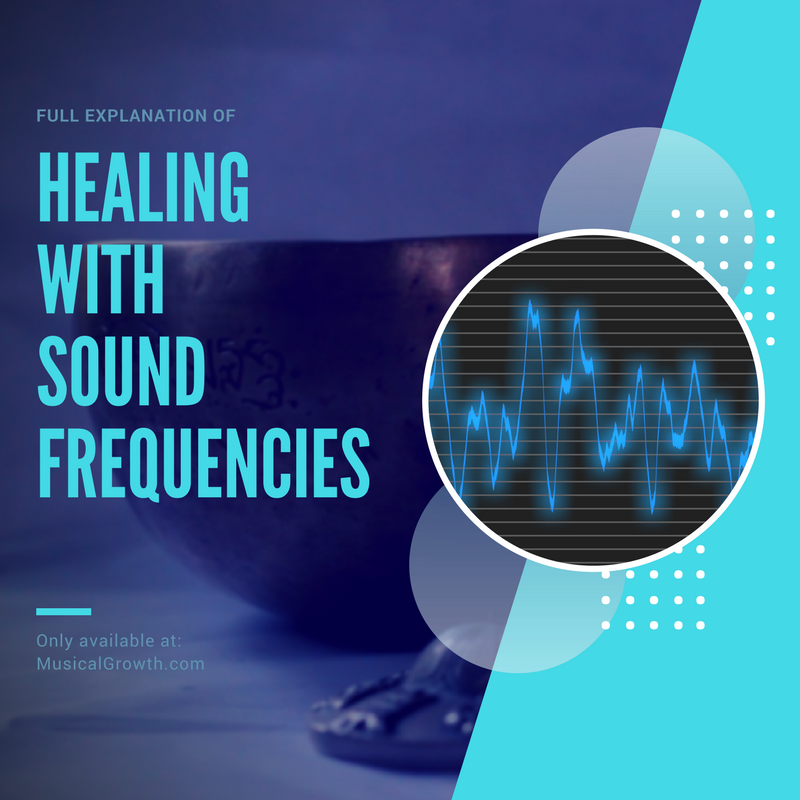
Yoga, Reiki, pranic healing, salt therapy, and sound therapy, for example, have been around for thousands of years and have stood the test of time. Before attempting Western medicine to cure, relieve, or prevent bodily pain, consider healing with sound frequencies and sound therapy.
Healing with sound frequencies has been around since the use of Tibetan singing bowls began over 2,000 years ago (read more about the history of singing bowls here). So how does it work? What are the frequencies? Can it be done at home?
I hope to answer all your questions with this article and help spread knowledge and truth about sound therapy.
The organization of this article:
- Why “Frequencies”?
- Why “Sound”?
- How does it heal?
- What are the specific frequencies?
- Is it real?
- What does MusicalGrowth use?
- Home Test
Why “Frequencies”?
Before I go giving specific numbers for chakra-specific tones, let me answer this introductory question: what are “frequencies”?
“Frequency” is a measurement of how often something occurs on a recurring basis. One full completion of this repeating pattern is referred to as a “cycle.” So frequency is a measured number defined by how fast these cycles occur.
| Frequency = |
cycle ——- (cycles per amount of time) time |
When it comes to defining pitches or tones, the “frequency” is defined more specifically by measuring how many cycles occur per second – which is referred to as “Hertz,” named after Heinrich Hertz (1857 – 1894), a German physicist who made important contributions to the scientific study of electromagnetism. “Hertz” was established as a measurement by the IEC (International Electrotechnical Commission) in 1930.
| Hertz = |
cycle ——- (cycles per second) second |
Most everything that vibrates can have a Hertz measurement including sound, radiation, computers, etc., but as far as sound waves go, not all frequencies can be heard by the human ear.
The average person can hear a range of 20 Hz to 20,000 Hz; whereas, most of the important sounds we hear on an everyday basis range from 250 to 6,000 Hz.
Our hearing becomes weaker as we age as well, so those in their twenties have no problem hearing tones at 20,000 Hz but older people over 60 years-old have a difficult time hearing tones above 8,000 Hz.
To give a few examples (to hopefully put these numbers in perspective):
- 0 to 20 Hz
- Lowest note on the organ is 8.2 Hz
- Lowest note on the tuba 16.4 Hz
- 20 to 80 Hz
- Lowest note (A0) on a concert grand piano is 21.8 Hz
- Lowest note on a string bass (E) is 41 Hz
- 80 to 160 Hz
- Lowest string on the guitar (E) is 82.5 Hz
- Open G-string on the guitar is 98 Hz
- 160 to 500 Hz
- High open string on the guitar is 330 Hz
- 500 to 1,600 Hz
- Middle C sounds at 523.25 Hz
- The highest frequency on guitar is around 900 Hz
- 1,600 to 4,000 Hz
- Highest note on the flute is 2,093 Hz
- Highest notes on the piano tops out at 4k Hz
- 4,000 to 10,000 Hz
- Cymbals and percussion are around 7k Hz or 10k Hz
- 10k to 20k Hz
- CRT television emits a tone of 16,744 Hz
- 106Hz (megahertz)
- Microprocessor clock speed or electromagnetic wave frequency
- 109Hz (gigahertz)
- The standard of wireless signals is 2.4 Ghz
- An iMac with an Intel Core i5 processor spins at 3.46 Ghz
- 1012Hz (terahertz)
- Infrared light exists around 300x1010to 430x1012Hz
- Visible light exists around 430 Trillion Hz to 750 Trillion Hz (Red to Violet)
- 1015Hz (petahertz)
- X-Rays function at 300x1014to 300x1017Hz
- 1021Hz (zettahertz)
- Cosmic rays are around 300x1019Hz and above
Why “Sound”?
Everything in the universe, everything that exists within our dimension’s laws of physics has a vibration – from string theory to cells to light to cosmic rays – everything vibrates.
When “sound” occurs, especially lower frequencies, it activates certain resonant spaces depending on the frequency/space relation. Even different materials can be manipulated by frequencies because of sympathetic vibrations. When striking a low C on an acoustic piano, all the above C’s and its relative harmonic series resonate. This is because of the natural occurrence of the overtone series (also known as the harmonic series).

Without getting into overtones TOO much, each acoustically made tone emphasizes multiple overtone pitches existent within a naturally made sound (not electronically manufactured). Instruments sound different from one another because of this variation in overtone combination.
For example, if the listed instruments below were to each play the same note of A-440 (the pitch A at 440 Hz) they would sound completely different because of the overtones that exist within each instrument’s timbre:
- Flute at A440 includes: 880 Hz
- Violin at A440 includes: 880 Hz, 2.2k Hz, 2.64k Hz, 3.08k Hz, & 3.52k Hz
- Clarinet at A440 includes: 1,320 Hz, 3.08k Hz, and 3.52k Hz
When it comes to sound healing, the body resonates at certain frequencies. Have you ever wondered why you feel the beat at the club? Or maybe you’ve felt your heart flutter with certain songs?
Sound healing focuses on specific frequencies that resonate with our chakras, or sources of life energy (chi).
The reason Tibetan singing bowls work so well in sound healing is that the metal alloys (5, 7, 9, or 12 different metals hand-hammered together) create some of the purest tones that maintain unwavering frequencies after ringing.
Music is a bit different though. Music can be defined as organized sound. Sound can be defined as vibrations that travel through the air, water, or other medium. Usually, nature creates sound in an unorganized or chaotic fashion with no purpose. When sounds are organized with human intent and purpose behind them, we then refer to it as “music.”
That is why is it called sound healing and not musical therapy. Musical therapy is the act of performing, creating, or listening to music specific to someone’s emotional preferences (albeit, there are many more details to this that I’m unaware of as a non-trained music therapist). Sound healing is primarily using “sound” as a form of noninvasive healing.
How does it heal?
It is all about the chakras.
Although there are actually 11 total chakras, the Western world focuses on the less dangerous seven (7): root, sacral, solar plexus, heart, throat, third eye, and crown (from the bottom of the spine to the top of the head).
It is said, that these spinning wheels of energy soak in the life force around us and release the byproducts after processing – much like breathing (the intake of oxygen leads to the exhale of carbon dioxide).
As we take in energy, these chakras (or “wheels” in Sanskrit) spin clockwise. As the byproducts are expelled, the wheels spin counter-clockwise (according to Master Stephen Co). The spinning occurs at a certain cycle in time and therefore can be measured in terms of frequency, thus bringing us back to its relation to sound.
When these wheels of energy spin too fast or too slow, it can affect the rest of the chakras (like the domino effect). Imagine a car with only four wheels (instead of 7!) – if one of the tires were flat, the weight of the car would be skewed causing abnormal wear on the other tires. If one is out, the others are negatively affected.
So it’s just as crucial for our health to check on the proper “spinning” of our chakras. It’s like consistently checking on our car’s tire pressure to ensure proper functionality.
By sounding a certain pitch (with a specific frequency) that resonates with one of our “flat” wheels of energy (or chakra), we can begin to coerce and influence the irregular cycle to spin at a more natural pace or frequency. Much like sympathetic vibrations in the laws of acoustical engineering.
So in sound healing, Chakras are influenced by sound vibrations to spin at the proper frequency. This, in turn, aligns our chakras and again allows the body to more naturally take in the life force around us. This enables the tension-free channelling of energy through to the entire body.
Sound healing is essentially helping to remove blockages in our chakras that stop the flow of energy in our body.
The body itself is a product of nature and when allowed to function freely (when all chakras are aligned), a natural healing process occurs. The body knows how to heal itself already, we just need to let it. By removing blockages in our “energy body” or the chakras, we allow this process to happen.
What are the specific frequencies?
Most might think the next part is a divine secret withheld behind expensive fees. Well, you’re wrong! The great thing about spiritual teachers and true knowledge is that it is made available to all. Humanity should be able to access such power. No one should withhold valuable information if they truly care about the welfare of their fellow neighbor.
Unfortunately, there have been many systems used in the last few hundred years. But I’ve done my research and found the best system verified by Tibetan handmade chakra bowls (my full explanation of “why” can be found in the sections below). These numbers are primarily based on Jamie Buturff’s research based on Mark Rodin’s god particle mathematics.
So without further ado, my research has brought me to trust a few sources that I’ve compiled to make this table:
| Chakra: | Element: | Color freq: | Vowel: | Frequency (Hz): | Note (A=432): |
| Root | earth | red | Uuh
(like “cup”) |
228, 456, 912 | ~ Bb |
| Sacral | water | orange | Ooh
(like “new”) |
303, 606, 1212 | ~ Eb |
| Solar Plexus | fire | yellow | Oh
(like “low”) |
182, 364, 728 | ~ F# |
| Heart | air | green | Ah
(like “law”) |
128, 256, 512 | ~ C |
| Throat | sound | blue | I
(like “eye”) |
192, 384, 768 | ~ G |
| Third Eye | light | indigo | Ay
(like “say”) |
144, 288, 576 | ~ D |
| Crown | thought | violet | Ee
(like “see”) |
216, 432, 864 | ~ A |
These frequencies are multiples of each other. For example, the Crown chakra resonates at 216 and the double of 216 (which is 432) and the double of that (which is 864). The reason is, that it’s the same “note” just an octave higher.
Each chakra is located at a specific point in the body:
- Crown – the top of your head
- 3rd eye – between your eyebrows
- throat – between the collarbone and extends both upward to the eyes and down to the heart
- Heart – right over the heart
- Solar – abdominals, starts at belly-button and goes up to the breastbone
- sacral – below the belly button
- Root – the base of the spine
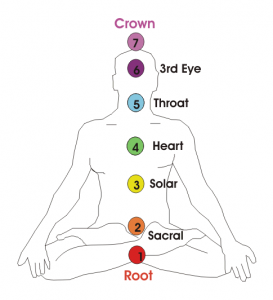
Is it real?
Are chakras, sound healing, and “magical frequencies” real?
I know most people will doubt the “truth” behind sound healing and its benefits. BUT. Let’s think objectively. Sound is a physical vibration, so odds are its physical effects will, in some ways, affect us as well (seeing as how we are physically present as well).
Within our laws of acoustics, sound resonates within a given space – think of an acoustic guitar’s hollow body or how when you blow over an empty bottle a whistling tone happens. Without getting into acoustical engineering, a certain area or space resonates better with specific pitches or tones.
Our body is made of around 60% of water. Sound waves move much faster (several times faster) through water in comparison to air AND can travel farther distances.
It’s only logical to conclude that the spaces in our body are susceptible to the physics of sound as well, thus reacting similarly. Sympathetic vibrations occur when presented with specific frequencies or tones – why would our body be any different?
As far as chakra-specific frequencies, there are very few sources for objective research to be found. Mainly because there have been numerous systems used in sound healing, including:
- Steven Halpern’s 7-note scale (began in 1975)
- Randall McClelland’s harmonic series (began in 1988)
Steven Halpern is one of the most well-known composers of chakra healing music since his debut album, “Chakra Suite,” in 1975 which has sold almost a million copies by now. Halpern conducted sonic research involving a seven-note scale (C, D, E, F, G, A, B) which he believed to resonate best with our chakras after experimenting with hundreds of people in 1985.
A system in 1988 coined by Randall McClellan, assumed that exact pitches varied per person and focused primarily on overtones and harmonics. Depending on each person’s specific resonant “note,” each overtone above this note would then be most effective. For example, if “C” was a person’s fundamental tone, then:
- The 2nd harmonic would resonate with the Root chakra (C)
- The 3rd harmonic would resonate with the Sacral chakra (G)
- The 4th harmonic would resonate with the Navel chakra (C)
- The 5th harmonic would resonate with the Heart chakra (E)
- The 6th harmonic would resonate with the Throat chakra (G)
- The 7th harmonic would resonate with the Brow chakra (Bb)
- The 8th harmonic would resonate with the Crown chakra (C)
But as stated by McClellan, there is no clear indication of which tones correlate the best with the seven chakras. Other researchers before the early 1990’s concluded that no one system works out of all the convoluted ideas of frequencies and chakras.
I was also skeptical of a precise system until I came across the works of Jamie Buturff, a mathematician known for his work with the Rodin Coil and Vortex-Based Mathematics. In his research involving sound healing, he states the “correct” frequencies that he found to work best with mathematical logic and observed healing evidence conducted in what he calls his “lab.” Kind of crazy. But when the guy speaks, you soon realize he’s a genius. You can watch his explanatory video here.
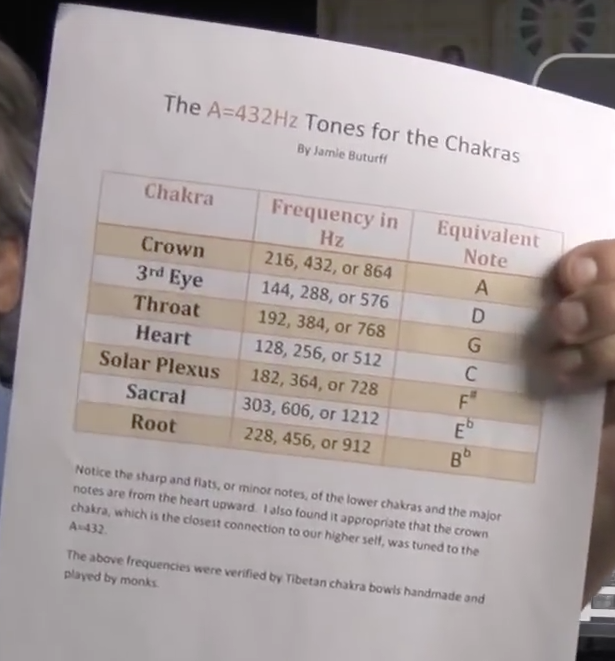
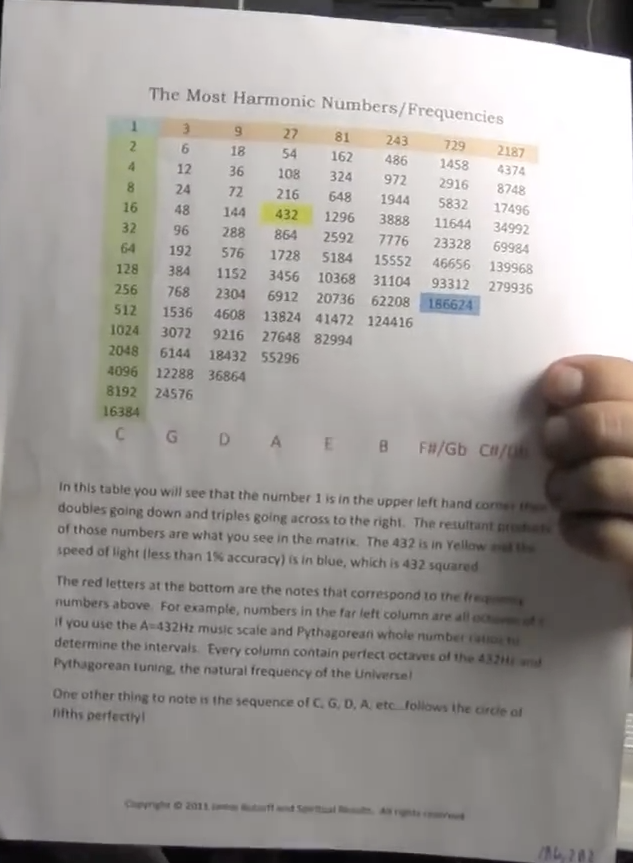
These once-available PDFs created by Jamie Buturff are now only shown in his explanatory video.
Cymatics
Every musician should know about cymatics. A form of sound study coined by Hans Jenny in the first half of the 20th century – cymatics is where a surface is vibrated by sound and particles placed on the surface then move according to the driving frequency and its correlating geometry.
Essentially, cymatics gives shape to sound!
It’s hard to explain. However, the experiment’s purpose would be to see how CLEAR the resultant shapes are when comparing 432Hz vs. 440Hz. Click the photo below to watch the video and get a glimpse of what cymatics is all about (video provided by Jaime Canaves and HolonMusic432hz.com).
So for ease of comparison, I took screenshots and placed them side by side. In the image below you’ll find the resultant shapes of a C-major scale:
- On the left, the scale is tuned to 432 Hz.
- On the right, it’s tuned to 440 Hz.

As you can see neither system outputs clear shapes across the entire scale. 432 Hz might have slightly more consistent shapes, but 440 Hz is not much worse.
These results prove that correlating the seven chakra tones to the Western-tuned system of C, D, E, F, G, A, and B is FALSE. Chakra tones are not specific to the equal tempered scale as shown by the inconsistency of the A=432 Hz scale.
Therefore, chakra tones are slightly off and more specific to each chakra.
Too bad we can’t just use a consistent Westernized scale, huh? So let’s not be lazy. Let’s be more accurate and do away with familiar tuning systems.
~ Like the post? Please consider supporting my current work ~
What system does MusicalGrowth use?
I’ve chosen the specific frequencies from Jamie Buturff’s research (the frequencies I’ve listed in the What are the specific frequencies? section above). The reason I follow his findings is because of his logical arguments and mathematical reasonings backed up by Pythagorean tuning and utilization of the naturally occurring overtone series.
Listen to “Once Hidden,” a MusicalGrowth album using these frequencies!
To begin with, the Western world’s equal temperament system of tuning isn’t natural and slightly alters the overtone series. It’s altered a bit to help create an equal 12-tone system by equally dividing the octave into a logarithmic scale – which alters the overtone series slightly. It is based on the overtone series, but isn’t exact and is, therefore, less “natural.”
So why attempt to heal with notes proven to be less natural?
The reason I disagree with the most prevalent system I’ve seen online (involving the strict 7-note scale of C, D, E, F, G, A, and B tuned to A=440 Hz popularized by Steven Halpern and used by many singing bowl companies), is that the scale itself isn’t utilizing a natural tonal system!
There are 11 total chakras (not just 7). It’s a little too coincidental that our “apparently superior” Western-tuned 7-note, C-maj scale perfectly fits the Eastern tradition of sound healing. These cultures have used far different tuning systems far longer than the Western world has used their 12-tone system. The Eastern tuning systems involve not just 12 tones, but 19, 24, or even 31 tones! A 53-tone tuning system was calculated by the Chinese music theorist, Ching Fang, back in the 1st century B.C.E!
But. Back to sound healing.
Ideally, I think the changing overtone system used by the founder of the Sound Healers Association, Jonathan Goldman, is best. But for now, I’d rather write for the majority by using the fixed frequency system altered by Buturff so that each piece has the greatest chance of helping as many people as possible.
I’ll continue to use the fixed frequency system provided by Jamie Buturff’s research so as to help a broader audience until I become more acquainted and skilled in finding an individual’s specific resonance. I’m not yet convinced of the best method of approach though until I follow up with more research and credible studies.
Home Test
If you’d like to test these chakra frequencies at home, there’s a quick and simple exercise you can do that will only take 5-min! The best way to feel these frequencies is to sing the pitch on a certain vowel.
Try mimicking what happens in the video created by Ryan R., published in 2013. I’ll post the chart again below the video as a reference point for how to shape the vowels.
| Chakra: | Vowel: | Frequency: | Note (A=432): |
| Root | Uuh (like “cup”) | 432 Hz | ~ Eb |
| Sacral | Ooh (like “new”) | 480 Hz | ~ Bb |
| Solar Plexus | Oh (like “low”) | 528 Hz | ~ F# |
| Heart | Ah (like “law”) | 594 Hz | ~ C |
| Throat | I (like “eye”) | 672 Hz | ~ G |
| Third Eye | Ay (like “say”) | 720 Hz | ~ D |
| Crown | Ee (like “see”) | 768 Hz | ~ A |

Well?
What do you think? Did you feel any vibrations in your body? Were the specific vowels vibrating in the relevant chakras?
Conclusion
So. Complicated I know. But I hope this helps illuminate the vast world and long-standing traditions of healing with sound frequencies.
I’ll admit. Doing the research for this article was far more involved than I had thought. I’ve been involved with music my whole life and have a Master’s in Music Theory and STILL, this stuff was complicated to explain simply.
The world of noninvasive healing can sometimes be powered by the mind through the “Placebo effect,” but sound healing has a lot of science behind it.
My friend had once assisted with a sound healing seminar at Cal State University, Fullerton and volunteered to be the guinea pig for their demonstrations in four seminars in a row! After the last healing session, I remember he told me he felt a little strange but continued about his day. Apparently, though, the next four days were spent in the bathroom! His body reacted to the sound healing with diarrhea because all the chakra blockages he had were cleared to an extreme – his body flowed again and detoxed on its own!
So whether you “believe” in it or not, you should take a moment and consider keeping an open mind. Sound healing is worth a shot, right? Might as well! What’s the harm! (Well, maybe diarrhea – don’t go too far with it!).
What’s your opinion on sound healing? Have you had any experiences of your own? Let me know in the comments below!
If you want more explanations, I would recommend these books:
- Chakra Frequencies: Tantra of Sound by Jonathan Goldman
- Healing Sounds: The Power of Harmonics by Jonathan Goldman
- Tuning the Human Biofield: Healing with Vibrational Sound Therapy by Eileen Day McKusick
I hope this article helped! If it did, please consider signing up for the newsletter! Or supporting my current music projects: ![]() If you have more questions about chakras consider reading this short overview of chakra colors or take some time to clear them with a short meditation exercise.
If you have more questions about chakras consider reading this short overview of chakra colors or take some time to clear them with a short meditation exercise.
Want to hear MusicalGrowth’s album using these frequencies? Click here!
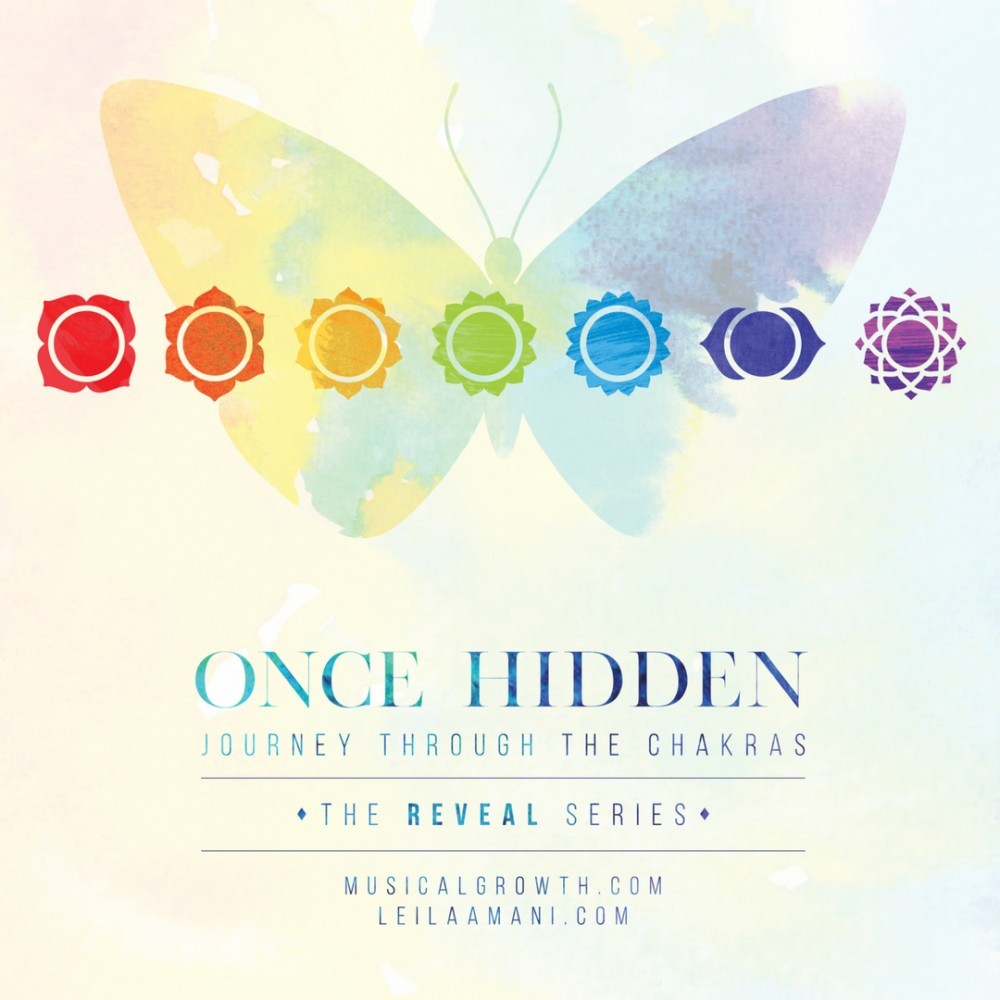
“Once Hidden” is an approved album to be used as a Reiki healing aid. As a collaborative project with Reiki healer, Leila Amani, this album is known to be highly effective in aiding chakra health!
Thanks for reading! And good luck with all your sound healing endeavors!
Chase
March 2018
*updated March 2024

* Wondering how I succeed with online business? Read how you can join in now!
Sources for this article’s research:
Have any concerns, questions, or things to share? Please feel free to comment below and I’ll reply to you as soon as I can! Otherwise, you’re welcome to email me directly and you’ll hear from me faster.
*I’m a professional musician, composer, artist, and performer! Join me on my adventures in making new music and art experiences!
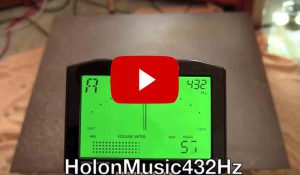
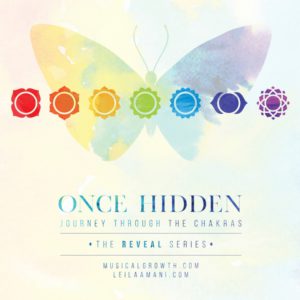
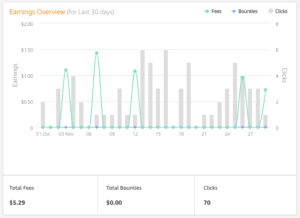
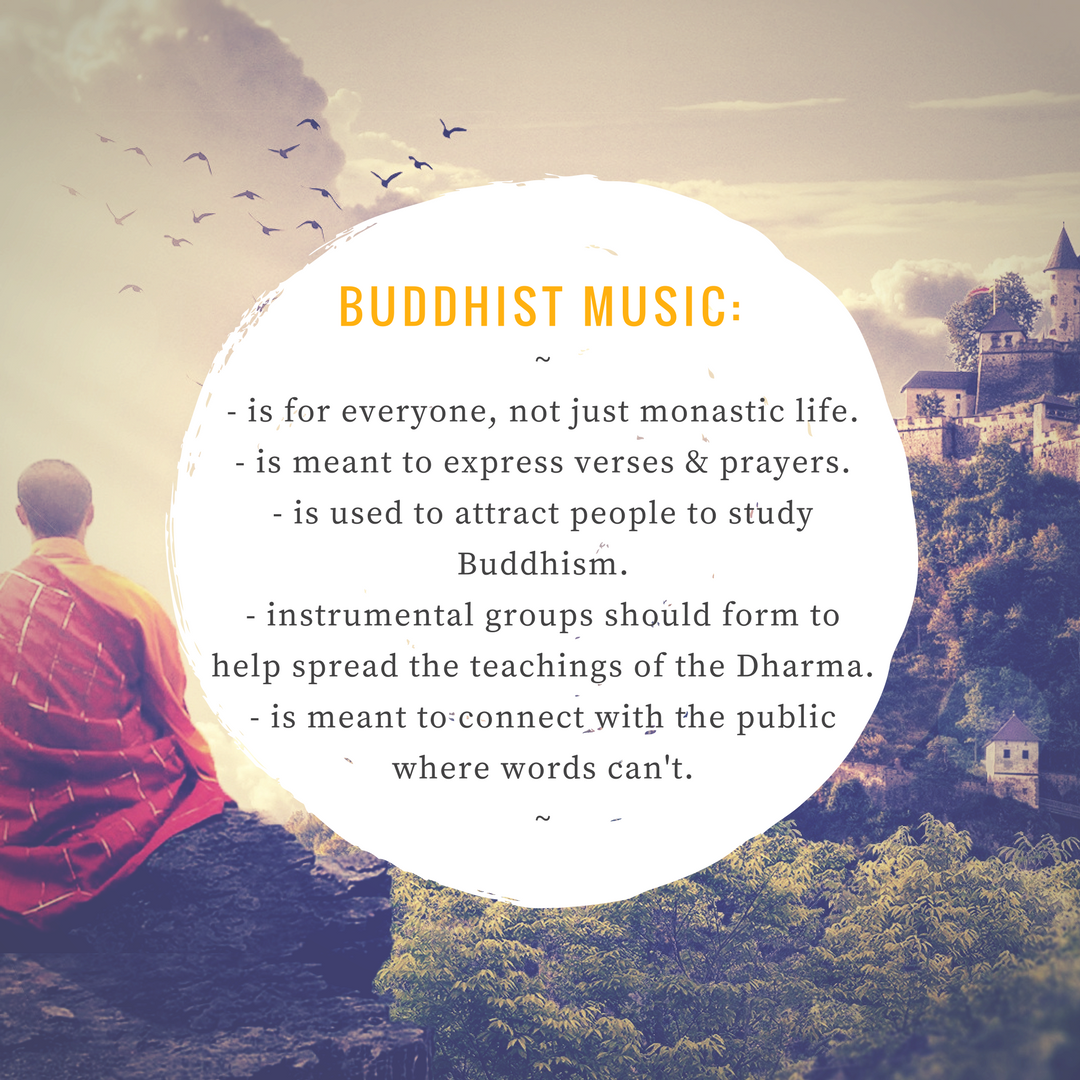


15 Comments
Pierre Smith · April 8, 2018 at 6:08 am
I am a singer, songwriter & musician. I have long known of the healing qualities of sound and believe this is great advice especially for people who are interested in alternative or non-invasive healing methods. I would highly recommend this practice to anyone in need of physical or spiritual healing !
Chase Chandler · April 9, 2018 at 12:14 pm
Hi Pierre! Sound is definitely far more powerful than many think. Thanks for sharing your opinion and advice! Sound healing is a great alternative for physical and spiritual healing, you are very right. Appreciate the feedback!
Jill · March 29, 2023 at 4:27 pm
Do you have any experience or work on Bee sounds in a hive, their frequency and effect on us and on themselves? Would love to hear your thoughts.
Warm Regards Jill
Chase Chandler · March 21, 2024 at 3:05 am
Hi Jill – thanks for your comment. This would definitely be a topic worth diving more into detail, because there would be a lot to find I’m sure. But I would guess that the activity behind the bee sounds in a hive would be enough to transfer a feeling of motion or excitement to the listener. I think it would act almost like white noise as well, since the buzzing sounds cover (I think) a large frequency range, so it would in a way block out the rest of the world a bit. Perhaps this is one of the things a beekeepers like! Might be worth interviewing one in the near future. Thanks for continuing the conversation! I’ll definitely be thinking on this one.
Ryan · April 8, 2018 at 7:05 pm
I absolutely LOVE this website. I really do believe in the vibrations and the sounds of the world and how it can affect all of us in a certain way. I want to thank you so much for making this wonderful website. I also LOVE your logo. It’s so awesome man.
Chase Chandler · April 9, 2018 at 12:17 pm
Hi Ryan, thanks so much for your kind words! I really try to create helpful content that hopefully has the potential to improve people’s lives. I’m so glad you enjoyed the article and the website (and the logo!). I made the logo myself by the way, so I’m happy to hear some people like it! Thanks for stopping by – let me know if you’d like me to research anything further, or feel free to sign up for my newsletter to hear more from me. Take care!
Kyle J Findley-Meier · October 10, 2018 at 10:58 am
Thank you for making this research available! I’m grateful. I’ve been sharing these ideas with a lot of people since, and keep this page as a reference point.
Chase Chandler · October 10, 2018 at 1:15 pm
It is my pleasure – I’m very happy to hear you find my research valuable. I need to update this article since I’ve put this research to use on MusicalGrowth’s newest album “Once Hidden.” Try listening to it and see if you feel it’s effects! I’m still experimenting, but let me know what you think! Thanks for dropping a commenting and letting me know your opinion. Let me know if I can help in any other way!
Roben · October 7, 2019 at 6:44 am
Can i download frequencies you have listed from youtube and use it to balance chakras??
Chase Chandler · December 5, 2020 at 7:11 pm
Hi Roben! The frequencies I mentioned from YouTube aren’t necessarily meant for chakras, it was more an experiment of retuning to A=432. I’d recommend MusicalGrowth’s album, Once Hidden, for more specific use of certain frequencies for chakra balancing. Hope this helps!
Eric · March 26, 2024 at 11:06 am
Hello Chase,
Oh wow, I’ve always heard that sound can have a healing effect, but I never really looked into it in depth. It’s fascinating to think that something as simple as listening to certain frequencies could potentially align our energy and help us feel better. The idea that everything in the universe, including us, is vibrating and that sound healing works by aligning with those vibrations is intriguing. It’s like we’re all part of this big, cosmic symphony, isn’t it?
The bit about Tibetan singing bowls producing pure tones that can consistently target our chakras is particularly interesting. It makes sense that the stability and precision of these tones would be important for healing. And the fact that there’s a scientific and mathematical basis to all this, with references to Pythagorean tuning and natural overtone series, just adds another layer of credibility.
Stumbling upon this information feels like a blessing, honestly. It’s like uncovering a hidden piece of wisdom that’s been there all along, waiting to be rediscovered. Have you ever tried any form of sound healing yourself?
Chase Chandler · March 27, 2024 at 5:31 am
Wow, well thank you very much for your comment! Not everyone is as interested in these music theories, so it’s refreshing to hear from someone who is particularly taken by the information. But yes, you’ve hit every point spot on! I do agree that we are really a part of a grand universal symphony, whether we know it or not. I, myself, have not ever tried sound healing. However I have considered getting a certification in sound healing out of pure curiosity. So maybe in the future! Either way, best of luck with your own journey and research in this field. Thanks for leaving a response!
Jeff · March 26, 2024 at 11:36 am
Thank you, Chase, for your insightful article on sound therapy and its relationship with chakras. The concept of using specific sound frequencies to align and balance the chakras is fascinating and offers a unique perspective on holistic healing. Your explanation of how each chakra corresponds to different frequencies was particularly enlightening. It’s intriguing to think about how sound, something so integral to our daily lives, can have such a profound impact on our energy centers and overall well-being. I just might be curious to explore this further and experiment with sound therapy in my own meditation and wellness practices. The idea that we can use sound to enhance the flow of energy through our chakras and promote physical and emotional healing is a powerful notion.
Thanks again for sharing your knowledge on this intriguing topic!
Chase Chandler · March 27, 2024 at 5:33 am
It is my pleasure! Thank you for letting me know your thoughts after reading the article. Things of this nature can be rather different, but for some, it is endlessly intriguing! I wish you the best in your own experimentations with sound healing. It definitely makes sense once you start thinking about the possible effects of vibration! Thanks for stopping by.
Rhianon · December 6, 2024 at 2:40 pm
Hello, I am interested in producing healing affirmational music via edm. I read in your article that healing tones can’t be produced electronically. What if I recorded them from a live instrument and layered them into my tracks? Thank. you so much!